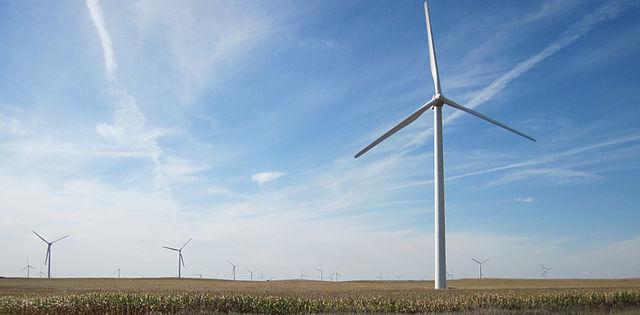Collaboration could be the answer in U.S. energy debate
Wind turbines, like these in a wind farm in Iowa, are popular sources of renewable energy today. (Photo by Bill Whittaker via Wikimedia Commons.)
The debate over American energy strategy remains heated, with President Barack Obama calling for more renewable energy in his inaugural address.
At the same time, though, Nebraska Governor Dave Heineman renewed the question of expanded use of fossil fuels by approving the path through his state of the Keystone XL pipeline. Obama rejected the Keystone pipeline last year, but said he would review it once more once additional approvals had been made.
And now the ball is back in his court. But the debate over fossil fuels versus renewable energy may not be as black and white as it seems at first blush.
Russell Gold, an energy reporter for the Wall Street Journal, says there hasn’t been a formal energy policy in the United States. since the 1970’s — and even then the policy was weak.
But recently, there’s been a strong push to cultivate renewable sources of power, like wind and solar, in the power grid, Gold said. They represent intermittent sources of power; if the wind stops blowing or the sun stops shining, then another source of power is needed. And Gold says natural gas is that other source of power.
The consensus among U.S. power plant and power grid operators, Gold says, is the U.S. will need to have sources of power that can quickly be turned on or off as renewable sources of power rise and fall.
Natural gas power plants are better equipped to quickly ramp up or down, unlike nuclear or coal plants, which can’t.
There’s potential for natural gas to work with renewables, Gold said, which could ensure renewables provide a greater amount of power, without putting Americans in a position where they might not have power when they go to flip the switch.
That symbiotic relationship, though, continues to be tough to be had.
Meanwhile, discussion over the Keystone XL pipeline continues to focus on whether it’s appropriate for this pipeline to bring crude oil from Canada to Gulf Coast refineries. From there it will be turned into transportation fuel, like diesel and gasoline, Gold said.
“At this point we don’t really have a good alternative for good old fashion crude oil to run all the cars we have in the country right now,” he said.
In order to figure that out, though, the United States need a coherent energy strategy, Gold says. First, what can the U.S. do to provide for its eletrical needs? What is the energy balance and how do we bring more renewables onto the grid?
“Then there’s transportation fuel, and as you can imagine, transportation fuel is an absolutely enormous market and consumes a huge amount of crude oil every day,” he said.
Activists are hoping that carbon trading, through a cap and trade type of system, will help address the comprehensive issue of both fuel for energy and fuel for transportation.
They argue, Gold says, though we found oil and gas in the ground, we can’t bring it out because if it’s burned there will be too much carbon going into the atmosphere. And that’s a different, and more coherent, he said, argument than the ones being made just three or four years ago.
Though he isn’t sure where the energy discussion is headed, Gold said he’s optimistic.
“There is a growing and possibly strong group voice out there talking about the need to stop burning fossil fuels, putting carbon in the atmosphere, and the real alternatives are nuclear and renewables,” he said.
